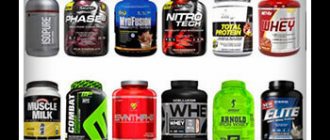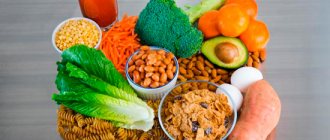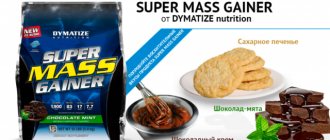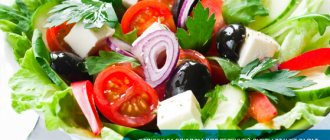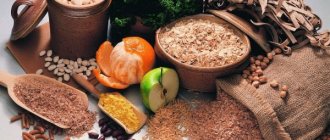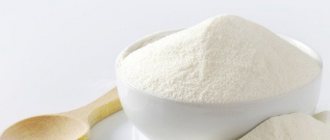Basic Muscle Building Principles
To achieve visible results as quickly as possible, you must adhere to several principles at the same time: eat right, exercise and rest regularly. Before we tell you what foods to eat to gain muscle mass, we'll lay out the basics of creating a healthy workout diet.
Balanced diet
Weight gain largely depends on the harmonious balance of proteins, fats and carbohydrates. These may be cheap foods, but they must include vitamins and nutrients to meet the body's needs from food. Below is what you can eat to gain muscle mass; the list includes only the best sources of nutritional supplements, divided into groups. Food for muscle growth should be varied so that you receive from food all the micro and macro elements that increase the body's regenerative abilities.
This means that you don't need to constantly expand your TOP foods or eat more and more chicken breasts; it may well be that adding a couple of spoons of healthy fats is enough.
To determine the amount of energy required for muscle growth, you should:
- Calculate the daily requirement of kilocalories for basic metabolism (function of internal organs, heat exchange, digestion). For men: 88.362 + (13.397 x weight, kg) + (4.799 x height, cm) - (5.677 x age, years). For women: 593 + (9.247 x weight, kg) + (3.098 x height, cm) - (4.330 x age, years).
- Assess your level of physical activity. The number of kilocalories of basal metabolism is multiplied by the human activity coefficient. For people with a sedentary lifestyle, the indicator is 1.2; doing 2-3 workouts per week increases it to 1.375. For those who play sports every other day, the coefficient is 1.55, for daily exercise – 1.725, and for heavy physical work throughout the day – 1.9.
- Increase the result by 10-20%. Such a calorie surplus will ensure gradual weight gain without harm to the body.
- Repeat the calculations in accordance with the increase in muscle mass.
Systematic training
Thanks to physical activity, metabolism accelerates, excess calories are directed not into fat, but into muscle tissue. It is recommended to conduct classes under the supervision of a trainer - he will set the correct technique for performing the exercises and give individual recommendations on nutrition.
To gain weight, three sessions per week lasting 1 hour are enough. Muscle growth is ensured by a gradual increase in working weights on exercise machines. In order for the body to become sculpted and proportional, you need to work out all muscle groups.
During training, the body needs a lot of energy. A few hours before the start of class, you need to eat food made from complex carbohydrates: cereals, vegetables, cereals, legumes. Such foods maintain muscle tone and maintain normal glucose levels. Immediately before the workout, you can drink a protein-carbohydrate cocktail or BCAA amino acids.
Recuperation
Muscle tissue grows while resting for 48 hours after training. In order not to harm the body, complete rest must be ensured for each muscle group. Sleep should last at least 8 hours a day.
Taking carbohydrates for muscle growth and fat burning
Among the other two macroelements (proteins and fats), carbohydrates provide the most energy, however, in addition, they are also involved in the processes of muscle tissue hypertrophy and fat burning. To build 1 kg of muscle mass you need to spend about 5000 kcal. This is two average daily food intake for an ordinary person. The best source of energy is only carbohydrates. They tend to transfer large amounts of energy into cells the fastest. Due to the existence of carbohydrates, protein structures are preserved, since protein should not be spent simultaneously on replenishing energy and on building material for muscles.
Carbohydrates are an important element for rapid fat burning. During a cascade of biochemical reactions occurring in the cell cytoplasm, the body converts lipids into energy substrates, ready to be broken down into energy.
List of foods for muscle growth
In order to increase muscle mass, you should consume a total of 500 kilocalories more proteins, fats and carbohydrates than the body expends during the day. The key to effective mass gain is increasing the calorie content of the diet, the correct balance of nutrients and the best foods for gaining body weight.
Protein products
Proteins are the main building material of the body, responsible for the growth of muscle tissue and its restoration. A lack of protein in the body causes muscle wasting, weakened immunity, and swelling. The daily protein requirement for weight gain is 2-2.5 g/kg body weight. It should be taken in small portions throughout the day, since no more than 40 g are absorbed in one meal.
Proteins consist of many amino acids involved in the formation of hormones, complex enzymes and other cellular structures. The following products contain the largest amount of protein:
- Meat. Red beef, lean pork, lamb, chicken, turkey are foods high in protein (up to 24 g per 100 g). Meat contains 8 essential amino acids that the body is not able to synthesize on its own.
- Dairy products. The protein content in hard cheese is very high - 23-30 g. In combination with lipids and calcium, the protein is easily absorbed by cells. Depending on the fat content, milk has 2.8-3 g of protein, cottage cheese - 14-16 g.
- Eggs. One medium-sized chicken egg contains 6-8 g of pure protein. Egg yolk contains a large amount of cholesterol and fat, so consuming it in large quantities is harmful to health.
- Seafood. Per 100 g of fish fillet there are 17-25 g of protein, which is absorbed in full. Protein content in seafood: red caviar - 29-31 g, mussels - 20 g, shrimp, crab - 19 g, squid - 18 g. Such food is considered dietary - the level of fat in its composition is minimal.
- Beans. Vegetarians replenish their protein reserves through plants of the legume family. Per 100 g of soybeans there are 36 g of protein, chickpeas contain 19 g of protein, beans - 19-24 g, lentils - 21-24 g, peas - 20 g. To facilitate the digestion process, legumes are combined with vegetables.
- Nuts. Among the nuts, the most valuable are: peanuts and cashews (26-27 g of protein), pistachios (20 g), almonds (18 g), hazelnuts and walnuts (15 g).
- Cereals. The leader in the amount of protein in the composition is buckwheat (10-12 g per 100 g of cereal). Semolina, oatmeal and millet cereals contain about 10-11 g of protein.
- Mushrooms. The protein content in mushrooms is as follows: champignons – 4.3 g; porcini mushrooms, boletus, morels – 3-3.3 g; saffron milk caps, russula, honey mushrooms, boletus – 1.7-2.5 g.
- Vegetables. Among vegetables, the richest in protein are garlic (6.5 g), Brussels sprouts (4.8 g), and spinach (2.9 g).
Foods with healthy fats
Fats are one of the most important nutritional elements. Their absence in the diet causes metabolic disorders, hormonal imbalance, and a decrease in overall immunity. Certain unsaturated fatty acids are not produced in cells; they are supplied exclusively in food.
The body's need for fat is 1 g/kg of dry body weight. The source of beneficial lipids should predominantly be plant foods (80%). Animal products occupy a small share in a healthy diet.
- Nuts. The fattest nuts – macadamia and pecan – contain 72-76 g of lipids per 100 g of product. Walnuts – 65 g, hazelnuts and pine nuts – 61 g; pistachios, almonds, cashews - 50-54 g, peanuts - 45 g. You cannot fill your entire daily diet with nuts - excess calories will lead to an increase in body fat.
- Seeds. Sunflower seeds contain 53 g of fat, sesame seeds - 49 g, poppy seeds - 47.5 g, flax seeds contain 42 g of lipids, chia seeds - 31 g, pumpkin seeds - 24.5 g.
- Oils. Sunflower oil is a high-calorie product, which mainly consists of polyunsaturated fats, which negatively affect human health. Healthy monounsaturated fats are found in olive, flaxseed, and corn oils.
- Avocado. A fruit that is 80% monounsaturated fatty acids. 100 g of avocado contains 15-20 g of fat.
- Dairy products. A large amount of fat can be obtained from hard cheeses (26-30 g), cottage cheese (9-18 g), and full-fat sour cream (20 g).
- Fatty fish. Mackerel, salmon, salmon, tuna are fish that, in addition to lipids (12-15 g), contain vitamins B and D, essential Omega-3 acids.
Slow carbohydrates
Slow or complex carbohydrates contain 3 or more molecules of simple sugars . This type of carbohydrates usually includes: starch, inulin, glycogen, cellulose, dextrin. Most complex carbohydrates are found in grains, beans, potatoes and other vegetables.
Metabolic processes with carbohydrates
Carbohydrates are metabolized in three ways:
- Due to glycogenesis - the formation of glycogen from simple sugars (glucose).
- Due to gluconeogenesis - the formation of glucose in the liver and kidneys from proteins, lactate and glycerol.
- Through glycolysis - the decomposition of glucose molecules to produce the required amount of energy.
Metabolic processes involving carbohydrates are regulated by the concentration of glucose in the circulatory system . The amount of glucose or carbohydrates in the blood depends on the composition of the food consumed. As a rule, the lowest glucose level is observed after waking up, after 7-8 hours of sleep.
Autonomous nutrition of the body during prolonged fasting occurs for the most part through the processes of glycolysis and gluconeogenesis. Immediately after rising, the body is in optimal condition to use stored fat. Therefore, to lose weight, it is recommended to engage in aerobic activity almost immediately after waking up .
The first hours after waking up are accompanied by the production of the maximum amount of catabolic hormones, in particular cortisol. The peak concentration of growth hormone decreases closer to 6-7 o'clock in the morning, by 8-9 o'clock cortisol is at its maximum maximum values.
Body types
There is no universal nutrition plan that could satisfy the requirements of any person. Sports mode largely depends on body composition. The body types are as follows:
- Ectomorph - short upper body, long limbs, narrow shoulders. Ectomorphs are energetic and active due to their fast metabolism and minimal body fat. Gaining weight is difficult and is only possible with high consumption of protein foods and other high-calorie foods.
- Mesomorphic - the body is proportional, the muscles are naturally voluminous and quite durable, there is practically no fat. Mesomorphs have the greatest tendency to gain muscle mass.
- Endomorph – round shape, large reserves of adipose tissue, poorly developed muscles. An endomorph can quickly gain muscle mass after eliminating excess weight. The fat layer is reduced with the help of a balanced diet and regular exercise.
Carbohydrates in sports[edit | edit code]
From oatmeal for breakfast to a baked potato for dinner, your body gets carbohydrates, its main nutritional fuel. During the digestion of food, the latter are converted into glucose. It circulates in the blood (also known as blood sugar) and is used by the brain and nervous system to produce energy. If brain cells are deprived of glucose, then mental activity weakens. And because the brain controls muscle function, you may feel weak and lethargic.
Glucose obtained as a result of the breakdown of carbohydrates is converted into glycogen - for storage in the liver (a third of its supply) and muscles (two-thirds of its supply). Once muscles begin to use glycogen, through a series of energy-producing stages, they again convert it into glucose.
It's no surprise that pasta, grain dishes (muesli, cereal), cereals, fruits, vegetables, sports drinks, nutrition bars and other sources of carbohydrates are favorite foods for athletes involved in endurance sports. To improve their results during competitions, they literally stuff themselves with carbohydrates. By the way, the latter are also necessary for strength athletes - in the right quantities, in combination with protein and fats. Glycogen, together with carbohydrates, is the main source of fuel for working muscles. When your carbohydrate stores run low, your muscles begin to get tired and heavy. Carbohydrates, especially when combined with protein and fat, are vital nutrients that stimulate your brain and muscles to perform strenuous strength training and build muscle mass.
Tips for gaining weight
In the process of gaining muscle mass, the body is constantly transforming, and every day the usual menu becomes more and more boring. You should combine different products to satisfy the body's needs. Regardless of the number of muscles in the body, it is appropriate to adhere to the following rules:
- Divide the daily menu into several main meals (up to 6 times). The body will be able to gradually absorb all the necessary substances without stress and overload.
- Avoid destructive food processing and use only gentle cooking methods - boiling, baking, stewing. Eat fruits, vegetables and herbs raw.
- Do not exceed your fat intake. In addition to the total calorie content of foods, the balance of all nutrients is also important.
- Control the amount of muscle gain - body weight should not increase by more than 0.6-0.8 kg per week. The body will use excess weight to grow fat tissue.
- Maintain a balanced mental state. Stressful situations stimulate an increase in cortisol in the blood. It can destroy muscle fibers and cause fat accumulation.
Healthy, high-calorie foods make it easier to gain muscle mass. To achieve the desired effect, you need to take a responsible approach to menu planning and exercise regularly.
Allowed and prohibited cereals for mass gain
The biggest controversy is caused by rice and semolina. Brown and brown rice can be eaten every day - it is a healthy complex carbohydrate. The same is true for buckwheat. But you should be careful with semolina: it has a very high glycemic index, and it does not provide any benefit to the body. Therefore, it is better to avoid it completely or eat it relatively rarely.
Resistant starch is resistant to digestion in the small intestine. It passes easily through the intestinal tract until it reaches the colon, where, like dietary fiber, it is fermented by bacteria. Thanks to it, healthy fatty acids are produced in the body. Therefore, some cereals are complex carbohydrates for gaining muscle mass:
- brown rice;
- barley;
- whole wheat;
- buckwheat grain.
A useful list of carbohydrates that help you lose weight and not gain extra pounds
Guys, we put our hearts into Bright Side. Thank you for revealing this beauty. Thanks for the inspiration and goosebumps. Join us on Facebook and VKontakte
Low-carb diets can bring quick results, but proper weight loss without carbohydrates is impossible. A calorie deficit is the main thing in weight loss, and a proper balance of proteins, fats and carbohydrates makes the process of losing weight healthy and high-quality. There are products in which the combination of complex carbohydrates, essential fiber, vitamins and taste is ideal. They leave you feeling full for a long time and help you avoid overeating. Shall we add it to the diet?
We at Bright Side have collected the most important information about carbohydrates, which nutritionists always emphasize, and have compiled a list of the most delicious and colorful helpers in getting rid of extra pounds.
Carbohydrates for weight loss
The most important thing about carbohydrates is energy for the body. And a good exchange of fats and proteins is impossible without them. However, carbohydrates are often blamed for weight gain. Is it so?
Based on their structure, carbohydrates are divided into the following:
Complex - contain starch, fiber, pectin, glycogen (bread, legumes, cereals, pasta, potatoes, vegetables, cereals, nuts, herbs).
- Slowly digested, giving a feeling of fullness (starches + fiber).
- Regulate intestinal function and maintain microflora (fiber).
- Helps remove fluid from the body (fiber).
- Maintain normal gastric mucosa and improve food digestion (pectin).
- Maintains essential muscle mass (glycogen).
Simple - contain glucose, fructose, galactose, sucrose and maltose (fruits, milk, all types of sweets and baked goods, beer, fast food).
- Causes a rapid rise in blood glucose levels.
- Gives a burst of energy.
When glucose levels rise, the pancreas begins to produce insulin, and the amount of insulin in the blood increases the more carbohydrates we eat. If complex carbohydrates raise and lower insulin levels gradually, then simple ones provoke surges and the need to eat something else.
If we constantly satisfy our hunger with simple carbohydrates, we get a constant release of insulin into the blood and its high concentration. High levels of insulin inhibit the absorption of fats, which contributes to excess weight.
This does not mean that you need to completely give up simple carbohydrates, but your diet should be balanced. We give preference to complex carbohydrates - and get slimmer with pleasure.
Types of carbohydrates
We get the vast majority of carbohydrates from plant foods. Animal food contains mostly proteins and fats. The exception is lactose, the milk sugar found in dairy products. Depending on their structure, carbohydrates are divided into simple (monosaccharides and disaccharides) and complex (polysaccharides).
All! Boring theory over! May biologists forgive me... I think the reader has long been asking the question - “Why eat that?!”
When gaining weight, it is necessary to eat both simple and complex carbohydrates, but in a certain proportion. On average, it is approximately 20% simple carbohydrates and 80% complex. Complex digestible carbohydrates are given untouchable priority. They provide maximum energy supply to the body, while the likelihood of fat deposition is low. But simple carbohydrates are also important for muscle recovery after heavy exercise and providing energy. It is also important that the fewer processing stages a product has, the more beneficial its energy value is for us.
The most desirable sources of simple carbohydrates include fruits, berries, and brown bread. Less desirable fast carbohydrates are most baked goods, chocolate, sweet drinks.
The best carriers of fiber are oatmeal and vegetables.
For clarity, we will describe the intake of carbohydrates during the day by analogy with proteins:
Products for gaining muscle mass
There are two categories of people in the hall: some came to lose weight, others came to gain it. For beautiful muscle definition, it is not enough to get rid of excess kilograms, you need to build muscle mass. And many athletes are faced with a problem: the weight is normal, training is on schedule, but the desired relief does not appear. To achieve your goal, you need to balance your diet to gain muscle mass.
Principles of nutrition for mass gain
Bodybuilding can be divided into two large cycles, which vary depending on the time of year and the goals of the athlete. This is mass gain and drying. In the first cycle, there is an active gain of muscle tissue by adjusting the diet towards increasing the total calorie content and heavy low-repetition training. Many athletes also take anabolic steroids, sports nutrition, amino acids and other supplements in order to maximize muscle growth.
During the drying period, which is carried out before the beach season or competitions, athletes radically change their diet and training plan. Begin to include daily aerobic exercise. To get rid of the layer of fat, they take special medications. These can be either certified pharmacy supplements or drugs prohibited by law. These activities allow you to achieve a beautiful, sculpted body - after all, the muscles have already been acquired through hard work and high-calorie nutrition during the period of mass gain.
A common mistake newbies make in the gym: they refuse to take carbohydrates to gain muscle mass. At the same time, the list of products inspires distrust in them: how can you eat rice if most nutritionists strictly prohibit it, since it supposedly contributes to obesity?
You should not compare the metabolism of an athlete who regularly receives exercise and an ordinary person who leads a sedentary lifestyle. Complex carbohydrates for gaining muscle mass (the list of products is presented below) are a necessary element of the diet. You can eat a lot of protein, but without enough carbohydrates you will never achieve truly impressive hypertrophy and a ripped body. Yes, during the fat burning period you will have to spend some time on a low-carbohydrate diet, but this time is extremely limited and only takes two to three weeks a year. Otherwise, changes in diet may cause metabolic disorders.
Basic Rules
The diet should be organized so that nutrients are supplied evenly throughout the day, so introducing three meals a day is a bad idea. Divide your daily calorie intake into 5-6 meals. There should be intervals of 3-4 hours between them. This is not the only important rule, there are others:
- Drink plenty of clean water. To gain muscle mass, you need at least 2.5 liters of water per day, because without fluid, many physiological processes necessary for muscle growth will occur slowly.
- The daily amount of calories for an adult athlete is from 3 to 4 thousand. At the same time, high-calorie foods should account for no more than 70% of the daily requirement, the rest should be nutrient-rich non-calorie foods like fruits and vegetables.
- Maintain a balance of proteins, fats and carbohydrates in your diet. The daily intake of carbohydrates is 50-60% of the diet, proteins – 30-35%, fats – 10-15%.
- Do not exceed the recommended dose of fats; give preference to vegetable fats. Completely exclude margarine, lard, smoked meats and sausages from the menu.
- Avoid fried and baked foods. Use gentle cooking methods: boiling, stewing, steaming. Vegetables are best eaten raw.
- Consume the main part of the daily menu before 17:00. Two hours before training - a portion of proteins and carbohydrates necessary to nourish the muscles. After training - sports shakes with protein, vitamins and minerals.
- Eat healthy foods with a high glycemic index within 3-4 hours after exercise to recover from exercise and replenish muscle glycogen stores. Although sweets and buns are high in calories, save them for exceptional occasions.
- Don't expect quick results. Normal weight gain is 600-800 grams per week. If you gain weight faster, this is a reason for concern, not joy: not only muscles are growing, but also fat tissue.
How to calculate your daily calorie intake?
To effectively gain weight, you should calculate in advance how much calories you need to get from food during the day. This can be done using a simple formula that takes into account your metabolic rate.
Since you should start eating according to this special plan gradually, to begin with, consume the amount of carbohydrates that is provided for people who are simply involved in sports.
- So, for women who have a slow metabolism, you need to consume 31 calories per day per kilogram of weight. That is, for example, if you weigh 57 kilograms, then you need to consume 1767 calories (31 x 57) from food daily. This figure may seem quite impressive to some, but if you take into account intense physical activity, then there is no risk of gaining extra pounds with such a diet.
- Lucky women who can boast of a fast metabolism should consume 33 calories per kilogram of their weight daily in order to effectively work out their muscles. A similar amount of calories is provided for men with a slow metabolism. But guys with a fast metabolism should consume 35 kcal per kilogram of their body weight.
After some time, a person can gradually increase the amount of carbohydrates to gain weight. In this case, to find out the new calorie intake rate, you need to add 10–20% to the number obtained from the formula described above. That is, a woman weighing 57 kilograms will now have to consume not 1,767 calories per day, but from 1,944 to 2,120.
https://youtu.be/MuAy4MbCYyc
To correctly calculate your diet, you should have a more or less clear idea of what kind of weight gain you need.
| Deadlines | Energy value |
| For example, if you plan to gain about 0.5% muscle mass, then you need to gradually add 250 calories to your weekly diet. | On average, for women this will be 30 extra calories per day, and for men - 40 calories per day. |
| In the first two weeks. | If you are a woman, add 25 calories every day; if you are a man, add 30 calories. |
| Half a month later. | You can start adding another 30–40 calories to your diet every day. |
| If the appearance of fat deposits is not observed with such a nutrition system. | Then you can add another 30 calories to your diet, but this time weekly, not daily. |
But if you notice that the fat layer on your body has begun to increase, then it is recommended to slightly reduce your carbohydrate intake.
But you can reduce their number by no more than a gram for every kilogram of your weight. Otherwise, the athlete will feel a lack of energy, his metabolism may slow down and he will not have enough strength to carry out effective exercise.
This precaution is especially true for athletes who do not focus exclusively on strength training, but combine it with endurance exercises. By the way, in this case, the amount of carbohydrates consumed per kilogram of weight increases to 8–9 grams.
https://youtu.be/NaB5mqmHvNk
Body types
Some athletes build muscle more easily, while others find it more difficult. Someone can train for years, lifting weights for breakfast, lunch and dinner, but will remain thin, without a hint of relief, while someone went to the gym for a couple of months - and already flaunts perfect abs. It depends on your body type. It influences your training plan and food choices for gaining muscle mass. Therefore, before creating a diet, it is important to determine your body type.
The hardest thing is for ectomorphs. People of this physique are excellent athletes and climbers: they are naturally lean, energetic, and agile. They have a fast metabolism, so an ectomorph can gain weight only due to serious health problems. But it is not easy for such an athlete to build muscle, so they are recommended to consume proteins before and after training.
If you belong to this category of athletes, do not be discouraged: yes, you need to balance your diet so that you get a lot of proteins, and the results will not come quickly. But when it appears, you will look great. The lack of fat and narrow bones allow you to achieve a very beautiful muscle definition.
The direct opposite of an ectomorph is an endomorph. If you have a hard time losing weight but gaining it back easily, have a naturally powerful build and solid, slow movements, you most likely have this body type. The good thing is that you are gaining muscle mass quickly. The bad thing is that it is not visible behind the adipose tissue. Endomorphs should train to burn as much fat as possible. If this is your case, after training, do not under any circumstances eat flour, fatty or unhealthy foods. You should keep your consumption of such foods to a minimum.
Mesomorphs achieve brilliant results in the gym the fastest. These are men of athletic build, with developed muscles, but without a tendency to be overweight. They do not need to put as much effort into increasing muscle mass as ectomorphs, but they also do not need to limit themselves in food, like endomorphs. Mesomorphs can afford greater freedom when choosing a training and nutrition program to gain muscle mass.
Indigestible carbohydrates
Dishes containing non-digestible carbohydrates (the list of products is given below) can be consumed in any quantity; they do not harm the body.
Carbohydrates in this group include:
- Starch. It has high energy value, but contains few calories. Creates a feeling of fullness for a long time, without putting on extra pounds even with active use. The substance is an excellent preventative against cancer, normalizes metabolism, regulates blood sugar levels, and improves immunity. Products containing large quantities of starch: peas, soybeans, lentils, potatoes, rye bread. This also includes pasta, oatmeal, buckwheat, and brown rice.
- Dextrin. This polysaccharide is a modified starch that is synthesized by heat treating potato or corn starch. Dextrin is absorbed by body cells better than basic starch and serves as an energy nutrient.
- Pectins. They act as adsorbents. After dissolving in water, pectin fibers from galacturonic acid residues are converted into a colloidal viscous mass, which absorbs toxins, carcinogens, and heavy metals. Thus, the functioning of the gastrointestinal tract is normalized, the intestines are freed from toxins. Pectins are found in root vegetables, algae, black currants, cranberries, and melons. They are also found in carrots, beets, cabbage, gooseberries, cucumbers, and eggplants.
Calorie content of food
To lose weight, you need to burn more calories than you take in. To grow muscles, you should follow the opposite principle, but do it in such a way that excess calories go into muscles and not into fat tissue. There are different ways to calculate the optimal amount of calories. Sometimes trainers recommend this method: write down the amount and weight of all food for the week, calculate the average daily calorie content, and then simply add 500 calories to the resulting figure. In theory, this is enough for the body to build muscle.
But there is an easier way to calculate the correct number of calories: multiply your weight by 30, the resulting number will be the approximate amount of calories per day. You need so much energy for your body to function normally. Since you want to build muscle tissue, you need a little more energy, so add another 500 calories to your total.
The complete formula for calculating daily calorie intake is as follows:
Weight × 30 + 500 = calorie intake
However, also take into account the specifics of your physique. If you are an ectomorph, 500 calories will not be enough, add 1000 at once.
Proteins for weight gain
Not all calories are created equal for your muscles: you can't eat a pizza that contains your daily dose of energy and think that it promotes muscle growth. To gain muscle mass, nutrition must be balanced, and proteins in one form or another should make up no more than 30% of all food.
Most bodybuilders do not count plant proteins, but only animal proteins, because they are better absorbed. You can also get your protein intake from supplements, but it is optimal if you consume both supplements and animal proteins.
The norm for an adult athlete is approximately 2 grams of protein per kilogram of weight. For example, if you weigh 85 kg, you will need 500 grams of chicken breast (contains 100 grams of protein), 100 grams of cottage cheese (30 grams of pure protein), 5 eggs, 2 glasses of milk per day. This is just an example, you can include more or less of the foods you like in your meal plan.
Carbohydrates account for the bulk of nutrition: 50-60%. If you have calculated the optimal amount of protein, calculating the daily amount of carbohydrates will not be difficult - exactly twice as much protein.
Keep in mind that carbohydrates can be simple and complex. Simple ones are absorbed quickly, causing a sharp jump in glucose in the blood. Complex ones are broken down more slowly, maintaining glucose levels over time. You should give preference to complex carbohydrates, which are found in cereals and legumes. However, if you need to replenish your energy reserves urgently, you can also eat fast carbohydrates: sweets. But you can’t take them as a basis for nutrition.
Finally, don't forget about vegetables and fruits - they are high in fiber, which slows down the absorption of food. Therefore, in reasonable quantities, fresh vegetables can be eaten without counting.
Which carbohydrates should you choose?
If the issue of calorie content is resolved by simple observation, then the issue of carbohydrate quality is important throughout the entire training cycle.
First of all, you need to understand what carbohydrates are. Usually there are two types:
- Slow (complex carbohydrates);
- Fast (simple).
It is important to find a balance, but the emphasis should always be on slow carbohydrates. They are digested and absorbed much longer, which is why they do not cause sharp rises and falls in blood glucose levels, which increases the production of insulin. Also, complex carbohydrates will ensure a uniform supply of energy. At some moments, the body needs a quick supply of energy, which means slow carbohydrates will be less preferable. Among these, two periods can be distinguished:
- Immediately after training;
- Before training;
- During breakfast (only in small quantities).
Slow carbohydrates are best consumed at lunch and dinner, but not earlier than 4 hours before bedtime. Fast drinks are best consumed in the first half of the day, a few hours before training and immediately after physical work.
Basically, the glycemic index allows you to understand the value of foods. The higher it is, the less healthy carbohydrates will be. The lower the better for the development of lean muscle rather than excess fat. If we highlight the most useful sources of complex carbohydrates, then it is worth noting the following products:
- Cereals (rice, oatmeal, buckwheat, etc.);
- Pasta from durum wheat;
- Vegetables.
For the fast ones, the best option would be:
- Fruits;
- Butter dough (only after training and in the absence of fat deposits);
Sometimes dark chocolate is allowed (at least 74%) and in moderate quantities (maximum 35-40 grams at a time). It contains not only carbohydrates, but also other beneficial substances.
For pre-workout intake (2 hours before), fruits are the best foods. Unlike other sweets, they contain fructose, which is more beneficial for the body than regular sugar. After training, honey, chocolate or even a small bun are allowed, but not for athletes with an endomorphic body type. A good alternative would be dried fruits (especially dates, dried apricots, figs, prunes).
Any sweets, carbonated drinks, cakes and fast food should be limited as much as possible. They contain too few “healthy” carbohydrates and almost always lead to an uncontrolled excess of calories and an increase in body fat.
It's no secret that carbohydrates provide the body with the fuel it needs to power through a tough workout, while proteins help build muscle. Indeed, this information can be considered basic. However, if you want to gain quality muscle mass without storing fat or lose weight with minimal muscle loss, you should adhere to some more rules.
Meal schedule
Stick to a routine: eat at approximately the same time every day. Chaotic eating can cause fat gain, and for people who actively train, it can cause slower muscle growth.
Breakfast
Breakfast options: oatmeal with milk, two hard-boiled eggs, toast with jam. Or corn porridge with milk, an omelet, a sandwich made from whole grain bread with butter. Rice porridge with milk, omelette, and dried fruits are also suitable.
For lunch you can eat rice, boiled chicken breast, cucumbers, tomatoes and some whole grain bread. Another day - pearl barley porridge, beef goulash, vegetable salad and a slice of rye bread. Or pilaf, shrimp, cabbage salad.
Complex carbohydrates
When creating menus for athletes, nutritionists and trainers give preference to polysaccharides. Due to slow absorption and weak dissolution in liquid, they do not cause sudden changes in blood sugar levels, which provokes increased insulin production, and saturate the body with energy gradually and evenly.
It is recommended for athletes to consume healthy carbohydrates during lunch and dinner (four hours before bedtime).
List of foods containing polysaccharides:
- in buckwheat and rice groats;
- in durum wheat pasta;
- in unprocessed oatmeal, bulgur;
- in whole grain bread (with bran);
- in legumes: beans, chickpeas, peas, lentils;
- in vegetables: cabbage, zucchini, tomatoes, leeks;
- in greens: spinach, lettuce;
- in fruits: oranges, apples, peaches, pears;
- in berries: plum, cherry;
- in dairy products: natural yogurt, low-fat kefir, low-fat cottage cheese;
- in drinks: freshly squeezed vegetable and fruit juices (tomato, carrot, orange, apple, pineapple).
In addition to carbohydrates, dairy products contain vitamins, phosphorus and calcium, which the body needs for normal functioning.
Best Foods for Muscle Growth
The first thing many coaches tell athletes is that it is good to eat egg yolk no more than twice a day, and as much white as you like. After all, this is a source of protein necessary for muscles! But the light did not converge on the egg white. By combining different foods to gain muscle mass, you will create a correct, healthy eating schedule.
Porridge provides the energy needed for training. They are rich in slow carbohydrates, as well as amino acids and protein.
Fish helps effectively build muscle. It contains not only protein, but also amino acids and Omega-3 polyunsaturated fatty acids necessary for the proper absorption of proteins. Therefore, do not deny yourself the pleasure of snacking on tuna, salmon, cod or mackerel. Ocean fish is best; it contains the most nutrients.
Fruits
Fruits contain a lot of fiber, vitamins and amino acids. The most useful for athletes are pineapples, melons, sour apples, as well as citrus fruits: grapefruits, oranges.
Poultry meat contains up to 50% protein, but it must be eaten without high-calorie skin. Beef and rabbit fillet contain creatine, an acid necessary for burning fat and building muscles. It is important that the meat is lean. In terms of benefits, the advantage is on the side of chicken and turkey fillet, beef, and rabbit.
Sweets
Not all sweets are equally harmful: among them there are also low-calorie desserts that will help replenish the supply of fast carbohydrates, and in addition, will bring pleasure. Sometimes the only reason for the painful feeling of hunger is the lack of pleasure and joy from food. Therefore, do not deny yourself small portions of dark chocolate, marshmallows or marmalade.
Dairy
Hopefully you're not lactose intolerant, because whole milk and fermented milk products are rich in calcium and vitamin D. There's a lot of debate about whether lactic acid bacteria are good for the body, but in any case, calcium is needed for muscle growth. A little trick: full-fat milk reduces post-workout pain.
Vegetables
Like fruits, vegetables are rich in fiber and beneficial substances such as vitamins and amino acids. Athletes are recommended to eat foods to gain muscle mass - for example, lettuce, cabbage, asparagus, spinach. And naturally fermented soy sauce will replace salt.
Flour
White bread, sweet buns and custard cakes are those foods that are recommended to be avoided. But it is not necessary to exclude all flour products from your diet. This is not even advisable: whole grain bread, bread with bran, yeast-free baked goods and diet bread are quite suitable as a source of carbohydrates.
Functional purpose of carbohydrates
The only source of carbohydrate formation is photosynthesis, a natural process that occurs in living plant cells. The class of these substances is quite extensive and includes both simple (monosaccharides, disaccharides, oligosaccharides) and complex (polysaccharides) compounds.
Many functions are performed by saccharides in our body: structural support, plastic, storage, osmotic and receptor. But their main and most important function is energy.
They are able to preserve proteins in the body and normalize liver function thanks to glucose. They make up about half of the average person’s diet. There is a table of the most energy-intensive components, among them starch and glycogen.
Simple carbohydrates are found in fresh fruits, milk, and sweets. Complex ones are more energy-intensive (starch, cellulose, glycogen) and are found in root vegetables, animal meat, and cereals.
Formally, there are five groups of products, which are classified based on the percentage of saccharides they contain:
- ultra-high carbohydrate products (65 grams of substance per 100 g or more);
- high carbohydrate foods (41 – 60 grams);
- with an average carbohydrate content (up to 20 grams);
- with low content (from five to ten grams);
- low-carbohydrate products (up to 4 grams per 100g of live weight).
They are also divided into saccharides with positive and negative effects:
- With a positive effect - complex chemical compounds of an unrefined nature, for example, starch. These compounds are found in grains, beans, soy, peas, nuts, pasta and vegetables. This food is high-energy, its polysaccharides break down into simple sugar for a long time and provide energy for the whole day;
- Negative - contain many “extra” calories. These are refined saccharides that are present in alcohol, confectionery, sweet soda, candy and ice cream.
Table of the most popular high-carbohydrate foods
Over 65 grams per 100 grams of product:
- rye bread (40-50 grams);
- wheat bread (up to 50 grams);
- buckwheat porridge (about 70 grams);
- peeled rice 72;
- granulated sugar (up to 100 grams);
- pink potatoes (up to 20 grams);
- semolina 70;
- legumes;
- chocolate and confectionery;
- drying, baking and empty;
- honey, jam, molasses, pastilles and syrups;
- products made from premium flour;
- cereals (oats, barley, corn, millet);
- all kinds of chips, snacks, corn sticks and bread;
- jam, marmalade, fruit in sugar;
- fruit cocktails, berry mousses and purees.
The most necessary substances for building muscle mass
Maintaining muscle tone and building muscle is very important for athletes and athletes.
In this regard, they are helped by calories obtained from foods containing the corresponding substances, since high-carbohydrate foods provide sufficient energy necessary for increasing body weight.
High carbohydrate foods are great for gaining weight. A diet of this format helps restore glycogen reserves in muscles and build new ones. Strength athletes need a high-carbohydrate diet to maintain muscle shape and tone.
Constant replenishment of carbohydrate reserves accompanies unprecedented muscle growth. The body needs to regularly consume at least 250 calories per day in order to gain half a kilogram of muscle mass.
To gradually build muscle, women need about 30 calories daily, and men - 40. Research shows that these are the optimal parameters to start building a figure. It should be remembered that these data are valid in the absence of fat deposits.
Increase your intake of high-calorie foods gradually to avoid fat gain. Start by increasing your daily intake by 30 calories, then gradually double that amount after two weeks. If you start to lose fat, reduce the number of calories in the buildup to the original number.
High-carbohydrate foods can be consumed in the form of solid foods and carbohydrate-based nutritional shakes. Thus, you can get up to four hundred calories from a cup of special pasta, a bun and a banana.
There is a misconception that it is important to eat a lot when gaining weight. It's not like that at all! The most important thing is correct carbohydrate rotation, distribution of meal times in combination with certain types of foods.
This diet will help you speed up the muscle building process. Carbohydrates are the body's fuel; if you burn calories, you lose weight.
Carbohydrate intake should be combined with equal portions of proteins and lipids. The exception to the rule is sports drinks, which do not allow you to consume solid food. It is important to drink these drinks during training, after which the effect will be insignificant.
High carbohydrate days in the life of an athlete
You should correctly distribute the required amount of muscle-forming enzymes and vitamins according to your own parameters. A table of fruits and vegetables for quick weight gain will help you with this.
On average, an athlete who wants to increase body weight should consume up to 7-8 calories per day per 1 kilogram of weight. Whereas a strength-trainer who combines strength-endurance exercises with other types of training must replenish 9 grams of carbohydrates per kilogram of body weight.
In sports, it is customary to divide carbohydrates into slow (more energy-intensive) and fast. According to the rules, when building muscle tone, it is important to consume slow carbohydrates 2 hours before training, and also fast carbohydrates an hour before training. After training, when the “window” time comes, it is recommended to eat and drink fast carbohydrates, they will restore the calories expended.
Side dishes are slow, including: rice cereal, buckwheat porridge, oatmeal and muesli, corn porridge. Fast polysaccharides contain glucose and sucrose, these are baked goods, sweets and chocolate. Let’s also not forget about fruits, which contain the necessary vitamins and minerals to maintain body weight balance while gaining muscle.
If you only have a bun on hand, you can, as an exception, eat that too. Of course, it contains enough calories and eliminates hunger, but it will not fill you with energy for a long time.
Athletes know very well: the reason for excessive fat gain is unused calories. It is necessary to give up sugar-containing foods: sweets, soda, factory juices and ice cream. If you can't live without pasta, avoid fatty sauces and mayonnaise.
Don't neglect slow carbohydrates, they are much more useful when gaining weight and will help you restore your energy balance. Eat buckwheat, legumes, potatoes, but only boiled or stewed. Avoid fried foods; remember, a tablespoon of vegetable oil contains about 100 calories.
What is the success of bulking?
Don’t believe those who say that proteins are more important than carbohydrates; only together they can help you gain weight and build an ideal body. Add proteins to your food chart as well. Excessive consumption of protein without catalysts will lead to the same obesity.
If you are unable to gain the required amount of calories on your own, buy a gainer, it will help you. For proportional muscle growth, you need at least 1.5 grams of protein per kilogram of body weight, because without protein, sugars turn into fat.
Add sodium to fast carbs after exercise. It will restore the balance of salts in the body, retaining water, and prevent muscle drying. It is also useful for weight gain to eat the food already mentioned above after training - during the “window”.
In this way, you can lower insulin, which inhibits muscle tone, while your muscles are saturated with useful nutrients. Such a meal could be buns or a croissant with jam after a workout, and 4 hours later a portion of pasta or white rice. You can also add smoked meat and corn to this list.
A rational approach, correctly calculated proportions and a carbohydrate diet will help you get the figure of your dreams in just a few months.
Proper and balanced nutrition is extremely important for each of us. But in some cases the need to carefully plan your diet becomes especially pronounced. This applies primarily to people suffering from various diseases, as well as athletes and those who want to get rid of the problem of excess weight. They constantly have to calculate the calorie content of foods and pay attention to the quality composition of food. And the topic of our conversation today will be a list of foods with complex carbohydrates, we will present it, and also consider a table for gaining muscle mass and losing weight.
Carbohydrates are an important part of the diet. They supply the right amount of energy to our body, ensuring the full functioning of organs and systems. Experts divide carbohydrates into simple and complex depending on the number of structural units they contain. Those carbohydrates, which are called simple, are easily absorbed by the human body, causing an increase in blood sugar, which is fraught with increased appetite, excess weight gain and metabolic disorders. As for complex carbohydrates, they contain many related saccharides and include a number of elements. Doctors consider them useful because, during digestion in the organs of the digestive tract, they gradually saturate the body with energy, which is why a person experiences a long-lasting and stable feeling of satiety. When consuming complex carbohydrates, the level of sugar (glucose) in the body increases gradually, slowly, which helps to avoid sugar spikes, mood swings and hunger pangs. Simple or fast carbohydrates are characterized by a high glycemic index - more than seventy, complex or slow carbohydrates are characterized by a low glycemic index - less than forty.
Complex carbohydrates are represented
:
Legumes (beans, peas, lentils, beans, etc.); - cereals and porridges (with the exception of semolina); — pasta made from whole wheat grains, barley; - fruits (which are low in sugar, namely kiwi, apples, grapefruits, pears, oranges, peaches); - berries (cherries, plums, etc.); — all kinds of vegetables (all varieties of cabbage, tomatoes, zucchini, bell peppers, onions, leeks, green beans, etc.); — greens (spinach, lettuce, etc.); - mushrooms.
In addition, complex carbohydrates are found in whole grain bread, which is baked from wholemeal flour. Unpeeled rice is rich in them.
Complex carbohydrates for weight loss
When losing excess weight, it is important to ensure a properly balanced diet with a combination of proteins, fats and carbohydrates. While losing weight, you should never exclude foods containing carbohydrates from your diet, since these elements are extremely important for the full functioning of the body. A deficiency of carbohydrates is fraught with a weakening of the immune system and the occurrence of a number of diseases.
Complex carbohydrates will help readers of Popular About Health lose extra pounds, because they ensure normal intestinal function, helping to improve peristalsis and nourish beneficial microflora.
In addition, it is complex carbohydrates that will help you not to break down during your diet by eating harmful and high-calorie sweets. Food rich in such elements will help you forget about hunger for a long time and prevent the occurrence of attacks of unmotivated irritability. The norm of carbohydrates when losing weight is calculated individually. On average, for every kilogram of body weight, the body should receive two to three grams of carbohydrates. During the oxidation of one gram of carbohydrates, four calories are released. But at the same time, food rich in complex carbohydrates should be consumed in the first half of the day (no later than six o’clock in the evening). Dinner should be protein.
photo #1
Complex carbohydrates for muscle gain
Carbohydrates are most actively involved in energy production. But in addition, such elements are necessary for building muscle mass and burning fat. After all, in order for an athlete’s body to build just half a kilogram of muscle, he needs to spend about two and a half thousand kilocalories. Of course, this is a significant amount of energy. And its best source can be carbohydrates. It is complex carbohydrates that are able to supply the cells of the body with the purest energy, and systems, organs and tissues prefer carbohydrates to fats and protein. In fact, a sufficient intake of carbohydrates allows you to maintain the required amount of protein reserves to perform its main functions - to build and subsequently restore all body tissues, including muscle tissue.
Among other things, carbohydrates are the most important component for effective fat loss. During the course of complex chemical reactions that occur inside the cells of our body, the body transforms fat into energy. Carbohydrates facilitate this processing at the cellular level. Therefore, if they are not consumed enough, fats are not burned as much as they could.
photo No. 2
People looking to build muscle should consume at least seven grams of carbohydrates per kilogram of body weight. At the same time, you need to increase the strength load, because the body will receive more energy, which will allow you to exercise more intensely and for a longer time, achieving better results. When working out for relief, you need to eat foods with the lowest glycemic index, since foods with a high glycemic index trigger the formation of fats. The best time to consume such products is the first half of the day.
Ekaterina, author of “Popular about health” (www.site) Google
— Dear our readers! Please highlight the typo you found and press Ctrl+Enter. Write to us what is wrong there. — Please leave your comment below! We ask you! We need to know your opinion! Thank you! Thank you!
Modern man has an obese physique, flaccid muscles and, in connection with this, a large number of diseases that did not affect him before, some couple of hundred years ago. What is the reason for this change? The main problem of modern people is their diet. Food companies have long established that consuming fatty foods is addictive, and people really like them due to certain instincts at the subconscious level (by eating fatty foods, you will get the necessary energy faster, which means your survival rate will increase). Why do manufacturers need this? This is necessary because fatty foods are very cheap to produce and yet have enormous nutritional potential. Ancient people did not have such an amount of fat in their diet and therefore fatty foods were something very beneficial, but in the modern world fatty foods have become widespread, our body greedily stocks up on it without realizing that the times when we jumped around the fire are long gone.
Drawing up a program for gaining muscle mass is not limited to the training program; a properly designed diet is of great importance and half the success.
There are several basic principles, if followed, the growth of muscle mass can be greatly boosted; ignoring at least one of these points will significantly reduce the effectiveness of the program, or even completely destroy it.
Advice from athletes
Athletes recommend not only choosing a healthy diet and counting calories, but also keeping a diary of nutrition and training. This will help you control your weight and adjust your diet taking into account your circumstances, body type, and health status. In the future, you will be able to develop an optimal diet for yourself. However, at the initial stage, consult an experienced trainer.
If a change in diet has caused an increase in waist size, train more intensely than usual, and cut your daily food intake by 10%. Only a systematic approach to sports and diet will help you always stay in shape.
Taking the drugs “Elecampane P”, “Mesi-Vit+” and “KiloLight” to help in the absorption of carbohydrates
The diet of athletes involved in energy-intensive sports should be saturated and balanced with carbohydrates. “Slow” or complex carbohydrates should prevail in the diet over “fast” (simple) carbohydrates. Carbohydrates provide energy for an athlete during training, so their consumption is very important. Typically, problems with the absorption of carbohydrates are infrequent, however, if carbohydrates are present in large quantities in an athlete's diet, their absorption may be impaired. To normalize the process of carbohydrate absorption, it is recommended to take plant-based drugs “Elecampane P” and “Mesi-Vit+” , since they will help you normalize digestion and relieve dyspeptic disorders associated with a high content of carbohydrates in the diet.
It would seem that a large amount of carbohydrates should provide more energy during training. However, in practice the situation is somewhat different. Excess carbohydrates are converted to fat and deposited in adipose tissue, which ultimately leads to obesity . Excess weight is a huge pile of health problems. Scientists have proven that people with increased body weight live 10 years less in contrast to people with normal weight, since excess fat puts a lot of strain on the cardiovascular system and contributes to the appearance of free radicals - the strongest carcinogens in the body. Remember: excess weight, sooner or later, will lead to illness, try to get rid of it in a short time. However, losing weight on diet and exercise alone is not so easy. A new herbal preparation “KiloLight” . KiloLight complex supplement , unlike third-party fat burners, does not contain chemical components, so when taking it there is absolutely no risk of side effects. On top of that, for convenience, the drug can be taken depending on the time of day. “KiloLight (morning)” will give you strength for the whole day and eliminate morning drowsiness. “KiloLight (day)” will help you not to eat too much, because only severe discipline and the “KiloLight” will lead you to an ideal figure; “KiloLight (evening)” is different in that it promotes weight loss even at night.
What to do if you don't have time to cook
If you don’t have time to cook, don’t overuse sweets, sports nutrition or fast food. Many dishes do not require much time to prepare, and you can cook for future use: cook buckwheat porridge for several days, steam the chicken. Use a slow cooker if you don’t have time to monitor food preparation. It allows you to drop in groceries, turn on a certain mode and timing, and go about your business. You can also order proper and healthy food for weight gain for a week from letbefit:
Glycogen and cellulose
These substances, which belong to the non-digestible group of carbohydrates, are also not deposited in the body in the form of excess fat when consumed in excess:
- Glycogen, the indigestible group, consists of a chain of glucose molecules. If for some reason its level in the body drops, glycogen maintains this level at normal levels. In addition, this carbohydrate restores muscle fiber mass after active exercise. The substance is found in fish, liver, beef heart, and red meat.
- Cellulose (fiber). It is a coarse plant fiber that is important for intestinal function. With the help of large fiber, toxic and ballast substances that are formed during the digestion process are absorbed. Small fibers ensure the functioning of the pancreas, spleen, and stomach, improving the digestion of foods. Gives a feeling of fullness for a long time, like all non-digestible carbohydrates. The list of foods containing cellulose includes unprocessed whole grains, nuts (hazelnuts, peanuts, almonds), greens and fresh vegetables. The list also includes fruits with seeds (grapes, apples, kiwi, pomegranate), and legumes.
A useful list of carbohydrates that help you lose weight and not gain extra pounds
Guys, we put our hearts into Bright Side. Thank you for revealing this beauty. Thanks for the inspiration and goosebumps. Join us on Facebook and VKontakte
Low-carb diets can bring quick results, but proper weight loss without carbohydrates is impossible. A calorie deficit is the main thing in weight loss, and a proper balance of proteins, fats and carbohydrates makes the process of losing weight healthy and high-quality. There are products in which the combination of complex carbohydrates, essential fiber, vitamins and taste is ideal. They leave you feeling full for a long time and help you avoid overeating. Shall we add it to the diet?
We at Bright Side have collected the most important information about carbohydrates, which nutritionists always emphasize, and have compiled a list of the most delicious and colorful helpers in getting rid of extra pounds.
What are carbohydrates?
In simple terms, a carbohydrate is a compound made up of carbon, oxygen and hydrogen. Fiber, sugar and starch are all forms of carbohydrates and can be classified as simple or complex.
Mono- and disaccharides are “simple” because they consist of one or two sugar molecules.
Polysaccharides are “complex,” long-chain carbohydrates and contain monosaccharide units.
Glucose, fructose and galactose are the three primary monosaccharides from which all carbohydrates are formed, and although each monosaccharide contains carbon, oxygen and hydrogen, their respective combinations in the molecule differ, giving them different qualities, not least taste.
Disaccharides include sucrose, lactose and maltose, and polysaccharides include starch, glycogen and fiber.


